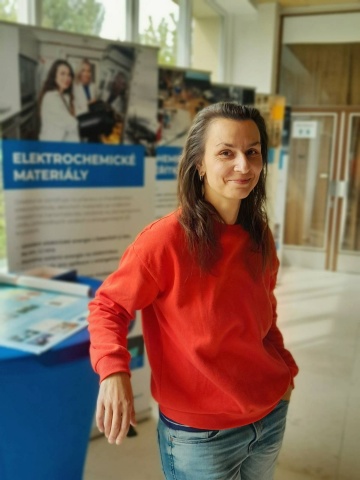
New training will help confront gender-based violence in academia
06. 05. 2024
According to the newest UniSAFE data, two out of three individuals have at one point encountered gender-based violence (GBV) in academia. Nonetheless, it remains an issue that is neglected in research institutions and universities. That is why the J. Heyrovský Institute of Physical Chemistry of the Czech Academy of Sciences (CAS) has contributed to the development of training that increases awareness about GBV – and thus helps institutions prevent it. As Michaela Svatošová explains, the training can be freely used not only by CAS institutes.
Gender-based violence is not only a problem in the private sphere but in the public sphere as well – including research and educational institutions. However, in Czech academia, it is a relatively underexplored issue. According to UniSAFE research, almost two out of three individuals have at one point encountered gender-based violence in an academic setting. Most commonly, they experience psychological violence (57%) and sexual harassment (31%). Women are more frequently subjected to violence (66%). Besides gender, other factors that put individuals at risk of GBV include sexual orientation, disabilities, and ethnicity. If these disadvantages intersect, the risk of violence increases.
Experiencing violence affects an individual’s mental health and the way they function at work or at school. Negative experiences with various forms of violence can impact one’s perception of safety and trust. It not only affects those who have experienced it, but also their families, friends, colleagues, and coworkers. It also influences how people perceive the institution in question, because occurrences of gender-based violence create a negative image of it.

Michaela Svatošová
Regrettably, UniSAFE data indicates that research institutions and universities struggle with a low awareness of what gender-based violence is, how to identify it, and how to resolve it. That is one reason why the overwhelming majority of cases go unreported, contributing to the tabooization and trivialization of this serious societal issue.
Before it’s too late
We should not address the occurrence of violence only once we are exposed to it or when the first case appears in our immediate surroundings. Instead, we must strive to prevent violence, inform colleagues about its various forms, and offer solutions. This appeal is directed not only at individuals but should first and foremost be heeded by institutions themselves.
The J. Heyrovský Institute of Physical Chemistry of the CAS wanted to respond to the lack of preventive measures in the environment of science, research, and education. Therefore, the institute collaborated with the Jan Evangelista Purkyně University in Ústí nad Labem on the project Prevention of gender-based violence in the working environment of public research institutions and universities in the Czech Republic. The project was initiated by the non-profit organization NORA and was funded by the Norway Grants.
The most important output of the project is the training package – specifically, the ten training videos complemented by test questionnaires. They are primarily intended for training employees of public research institutions and universities in the Czech Republic. Each video focuses on a different topic and places it within the context of gender-based violence. The videos present not only examples of physical and psychological forms of violence, but also outline less recognizable phenomena: economic violence, gender biases, gender-balanced expression, or the gender dimension in research. By informing about the forms of gender-based violence, academia could become a safer and fairer environment that respects equal opportunities for all.
The training was developed in several phases since the project was launched in 2022. The completed package has been available since March 2024. The Heyrovský institute was involved in putting together the video scripts and creating the questionnaires, and most importantly, participated in pilot testing, which also took place at the Jan Evangelista Purkyně University. As Svatošová explains, based on feedback from testing, they adjusted the questionnaires, clarified model situations, and added missing information. Subsequently, they helped develop a methodological guide describing how both institutions and individuals can make use of the training.
The training materials were then disseminated to academic workplaces. The aim is for the training to be adopted to a similar degree as is occupational health and safety training. Since the beginning of April 2024, the materials have been distributed to dozens of institutions, which are further spreading the word.
A welcomed training
Reactions to the training is very positive. As Svatošová says, “We are delighted that institutions are welcoming the existence of the training and are spreading the word about what we have to offer. We’ve also received positive feedback on the form the training takes.”
Testimonials: “Thank you so much for the information! We are currently addressing the need for a reasonable way to train our employees in this issue. The videos are great, thank you once again for sending them. We will definitely be using them.” / “I have gone through the first set of training videos, several questionnaires, and the methodological guide, and I am immensely grateful for this initiative and its results. To me, the videos and questionnaires seem understandable and well-structured; I hope they will be successful!”
Some of the topics addressed in the videos are more challenging, and thus elicit expectedly more critical responses – such as gender-sensitive language and expression.

Women are more frequently subjected to gender-based violence in academic environments.
How to go about it
To complete the training, employees are simply sent links to the training videos, which are complemented by the questionnaires. Employees verify the correct answers themselves after completing and submitting them. The Nora Center also offers additional options for working with the questionnaires – such as mapping, data collection, and analysis.
The training tests knowledge before and after completion of the training. Employers can thus gain insight into colleagues’ awareness of the topic, but also verify their knowledge of specific measures. For instance, whether they know whom to contact if a problem arises, which methodologies and regulations are valid for resolving their issue at hand, what options they have for timely resolution and rectification, and so on.
The training material is freely accessible in Czech and English. It includes a Methodological Guide for Implementing Training Packages (in Czech only), which explains how to best work with the questionnaires and videos and how to proceed when introducing the tool in a given workplace.
Prepared by: Michaela Svatošová, J. Heyrovský Institute of Physical Chemistry of the CAS
Translated by: Tereza Novická, External Relations Division, CAO of the CAS
Photo: Shutterstock; Michaela Svatošová’s archive
Read also
- A trapped state: The pandemic impact on public attitudes, trust, and behavior
- Aerial archaeology: Tracing the footsteps of our ancestors from the sky
- Archaeologists uncover ancient finds along Prague Ring Road
- Our microbiome largely depends on what we eat, says microbiologist Michal Kraus
- The ABCs of writing: Why did its invention mark a turning point for humankind?
- We learn, remember, forget… What can memory actually do? And can we outsmart it?
- New Center for Electron Microscopy in Brno opens its doors to global science
- The hidden lives of waste: What can we learn from waste workers and pickers?
- A unique lab is hidden right beneath Prague’s Vítkov Hill
- Renewables are a strategic investment in European security, scientists say
The Czech Academy of Sciences (the CAS)
The mission of the CAS
The primary mission of the CAS is to conduct research in a broad spectrum of natural, technical and social sciences as well as humanities. This research aims to advance progress of scientific knowledge at the international level, considering, however, the specific needs of the Czech society and the national culture.
President of the CAS
Prof. Eva Zažímalová has started her second term of office in May 2021. She is a respected scientist, and a Professor of Plant Anatomy and Physiology.
She is also a part of GCSA of the EU.